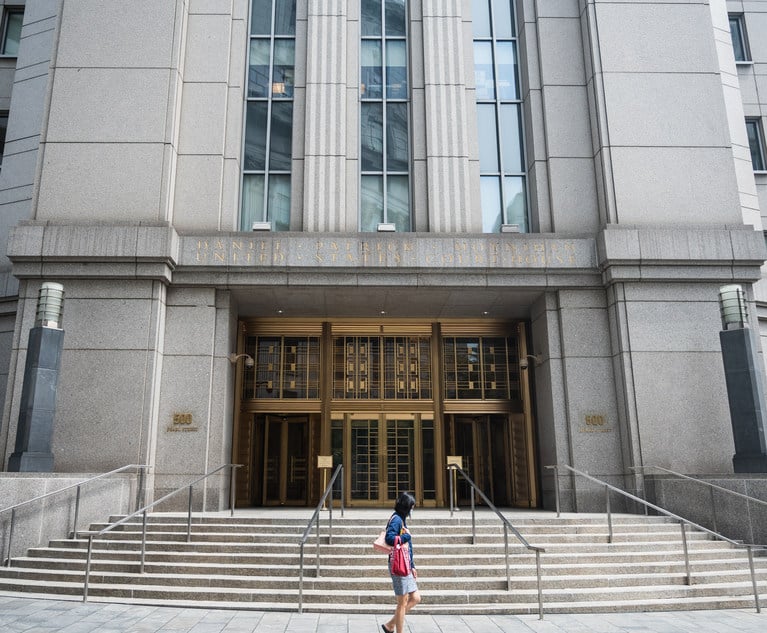It's 2020. Does the Market Know Your Firm's Brand Story?
Judging from conversations with law firm leaders, anxiety pervades the managing class. Their concerns have less to do with the acquisition of new business than the war for talent—at all levels, from first-year associates to senior partners.
February 26, 2020 at 12:00 PM
7 minute read
 Revenue growth among this country's elite law firms may not be as reliable as death and taxes, but it's pretty close.
Revenue growth among this country's elite law firms may not be as reliable as death and taxes, but it's pretty close.
Drawing on data from a cross-section of Am Law 100 and 200 firms and boutiques, a recent Citi Private Bank survey found revenues in the legal industry rose once again last year at a healthy 5.3%. That makes 10 straight years of solid revenue growth for most of those firms.
And yet, judging from our conversations with law firm leaders, anxiety pervades the managing class. Their concerns have less to do with the acquisition of new business than the war for talent—at all levels, from first-year associates to senior partners.
Since the Great Recession, law firms have recovered financially, but the ground under them that shapes the talent landscape has shifted. The demographic makeup of a firm's lawyers is now the subject of a new level of scrutiny from clients, the media, and often within firms' ranks. On this new terrain, even the most elite firms have endured body blows to their image.
They've been bruised by their struggles to attract and retain attorneys from diverse backgrounds. Ditto for women partners, some of whom have publicly taken their firms to task—and court—for pay inequities and mistreatment.
Among young attorneys, the challenges are just as great. Work at elite law firms is not as appealing as it once was to previous generations.
"Young people look at their lives much more holistically," notes Toni Wells, owner of Bespoke Marketing Partners, who provides consulting services to law firms. "They bring their values to work. "
Values and purpose matter to partners, too. A recent survey from Major, Lindsey & Africa noted that the number one reason partners leave their firms is not to chase more money. It's a lack of confidence in management and strategy at their former firms.
To their credit, many firms have responded with action. They have introduced mental health services, generous family-leave policies, business education training for associates, diversity and inclusion programs, flexible work arrangements, and higher starting salaries.
It's a great start, but there is more to be done.
Brand Alignment
Those efforts need to be complemented with consistent messaging around the firm's values, purpose, and identity. Effectively and frequently delivered, these messages can shape the beliefs and behaviors of employees—the culture that drives how firms deliver their services.
How should firms go about reconciling these various segments of the lawyer market they want to target? It starts with brand alignment.
And arriving at this alignment means first having a candid discussion around some big questions, which we call the three "p's." What position does your firm have in the market? What's your firm's purpose? And what principles does it stand for?
Historically, brand positioning has received short shrift by law firms. They were content to let it happen organically.
That's not good enough anymore. The competition for talent is too competitive. Potential recruits want and expect to see a firm's values on its website, social media channels and other communication platforms.
In addition to the changes in our culture, the market for law firms has been segmenting for some time—boutiques, alternative legal service suppliers, international vereins, national firms, etc. Firms must make clear choices lest they get stuck in an undefined netherworld. Those choices are not easy to make because it means choosing what not to do. And that can bruise egos.
"It is essential for firms to have a common understanding what it is they stand for and what it is they are good at," notes Deborah Farone, a law firm consultant and author of "Best Practice in Law Firm Business Development and Marketing."
In job interviews, most firms ask candidates to "tell their story." Firms should be able to crisply tell their own. That's why some firms have doubled down on key industries and practices while jettisoning others.
On its site, Orrick, for example, lists five main areas of focus: technology; energy and infrastructure; finance; litigation and IP; and transactions. That kind of focus makes it easier to communicate a firm's purpose and to build a strong and cohesive culture that breeds loyalty and resiliency in the face of change.
Messaging Matters
With brand alignment, firms can confidently craft core messages and authentic narratives that best reflect their purpose, principles, and position. These stories can shape employee experiences, serve as a ballast when firms encounter rocky waters, and even inspire.
When we think about brands that inspire, it's usually about companies that sell products like Nike, Starbucks, or Patagonia. Law firms sell intangible services, which makes it more of a challenge to rally around. But the intangible nature of legal work makes it even more critical that firms continually remind lawyers where they stand, what they do best, and how they make an impact.
Establishing an emotional connection is not talked about nearly enough in the context of brands for law firms. But humans, even lawyers, crave purpose and a sense of community.
Good old-fashioned storytelling remains the best way to elicit that emotional connection. Through stories, firms can reinforce their culture and remind lawyers of their shared purpose. And these stories don't have to be just about the past; they can be about a firm's destination, its North Star.
Some forward-thinking firms are putting new resources into this kind of messaging project. One law firm, for example, recently listed a job description for a communications manager responsible for providing "thinking and strategic counsel to develop marketing programs that convey our employer story, values, global practice, and vision."
To be sure, many firms have been consistently promoting their values through content. Morgan Lewis, for one, has been featuring content to support its efforts around diversity. For Black History month, it published a Q&A with a diversity recruiting manager at the firm, to cite just one example.
We should expect to see more collaboration between HR, diversity and inclusion, and communications departments, says Michael Coston, CEO of Coston Consulting, which provides consulting services to law firms: "Firms are increasingly strengthening their value propositions and messaging around diversity, which provides for strong alliances between diversity heads and CMOs. Firms are asking the right questions: How do we reach the right talent? How do we meet or exceed client expectations? How do we enhance our culture?"
A big part of a firm's culture can be detected in what it chooses to celebrate and share with their communities. Identifying the right stories, developing them, and sharing them is now more essential than ever.
There is fertile ground to cultivate. It's hard not to be moved by the incredible legal work, for example, that so many firms have recently done, standing up for the rule of law in areas like immigration, gay rights, and the First Amendment.
But to come alive and be useful for a firm's brand, these stories must be valued, shaped, and repeatedly told on all available channels and through varied forms. That kind of investment requires an extraordinary commitment. But the stakes—attracting and retaining top talent—couldn't be higher.
Jamie Diaferia is CEO of the international communications firm Infinite Global. Andrew Longstreth is the firm's head writer.
This content has been archived. It is available through our partners, LexisNexis® and Bloomberg Law.
To view this content, please continue to their sites.
Not a Lexis Subscriber?
Subscribe Now
Not a Bloomberg Law Subscriber?
Subscribe Now
NOT FOR REPRINT
© 2025 ALM Global, LLC, All Rights Reserved. Request academic re-use from www.copyright.com. All other uses, submit a request to [email protected]. For more information visit Asset & Logo Licensing.
You Might Like
View All

Southern District of New York Is Seeking New Clerk of Court

New York State Unified Court System Seeks Support Magistrates for NYC Family Court

Brooklyn DA Launches Virtual Currency Unit to Combat Crypto Fraud
Law Firms Mentioned
Trending Stories
- 1Litigator of the Week Runners-Up and Shout-Outs: Davis Wright Tremaine, Wilmer and More
- 2Forum Clause Axes $844M Case Against Reinsurer Over Deadly Plane Crash, Judge Rules
- 3Latham Adds Former Treasury Department Lawyer for Cross-Border Deal Guidance
- 4Understanding the HEMS Standard in Trusts
- 5Mergers Are About People, Not Paperwork: Here’s Why
Who Got The Work
J. Brugh Lower of Gibbons has entered an appearance for industrial equipment supplier Devco Corporation in a pending trademark infringement lawsuit. The suit, accusing the defendant of selling knock-off Graco products, was filed Dec. 18 in New Jersey District Court by Rivkin Radler on behalf of Graco Inc. and Graco Minnesota. The case, assigned to U.S. District Judge Zahid N. Quraishi, is 3:24-cv-11294, Graco Inc. et al v. Devco Corporation.
Who Got The Work
Rebecca Maller-Stein and Kent A. Yalowitz of Arnold & Porter Kaye Scholer have entered their appearances for Hanaco Venture Capital and its executives, Lior Prosor and David Frankel, in a pending securities lawsuit. The action, filed on Dec. 24 in New York Southern District Court by Zell, Aron & Co. on behalf of Goldeneye Advisors, accuses the defendants of negligently and fraudulently managing the plaintiff's $1 million investment. The case, assigned to U.S. District Judge Vernon S. Broderick, is 1:24-cv-09918, Goldeneye Advisors, LLC v. Hanaco Venture Capital, Ltd. et al.
Who Got The Work
Attorneys from A&O Shearman has stepped in as defense counsel for Toronto-Dominion Bank and other defendants in a pending securities class action. The suit, filed Dec. 11 in New York Southern District Court by Bleichmar Fonti & Auld, accuses the defendants of concealing the bank's 'pervasive' deficiencies in regards to its compliance with the Bank Secrecy Act and the quality of its anti-money laundering controls. The case, assigned to U.S. District Judge Arun Subramanian, is 1:24-cv-09445, Gonzalez v. The Toronto-Dominion Bank et al.
Who Got The Work
Crown Castle International, a Pennsylvania company providing shared communications infrastructure, has turned to Luke D. Wolf of Gordon Rees Scully Mansukhani to fend off a pending breach-of-contract lawsuit. The court action, filed Nov. 25 in Michigan Eastern District Court by Hooper Hathaway PC on behalf of The Town Residences LLC, accuses Crown Castle of failing to transfer approximately $30,000 in utility payments from T-Mobile in breach of a roof-top lease and assignment agreement. The case, assigned to U.S. District Judge Susan K. Declercq, is 2:24-cv-13131, The Town Residences LLC v. T-Mobile US, Inc. et al.
Who Got The Work
Wilfred P. Coronato and Daniel M. Schwartz of McCarter & English have stepped in as defense counsel to Electrolux Home Products Inc. in a pending product liability lawsuit. The court action, filed Nov. 26 in New York Eastern District Court by Poulos Lopiccolo PC and Nagel Rice LLP on behalf of David Stern, alleges that the defendant's refrigerators’ drawers and shelving repeatedly break and fall apart within months after purchase. The case, assigned to U.S. District Judge Joan M. Azrack, is 2:24-cv-08204, Stern v. Electrolux Home Products, Inc.
Featured Firms
Law Offices of Gary Martin Hays & Associates, P.C.
(470) 294-1674
Law Offices of Mark E. Salomone
(857) 444-6468
Smith & Hassler
(713) 739-1250






